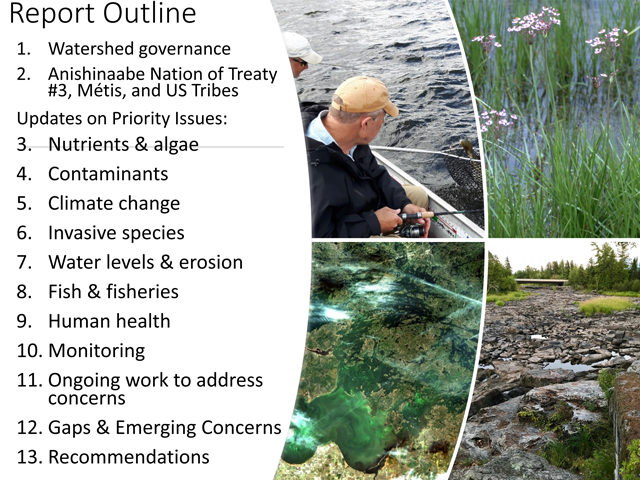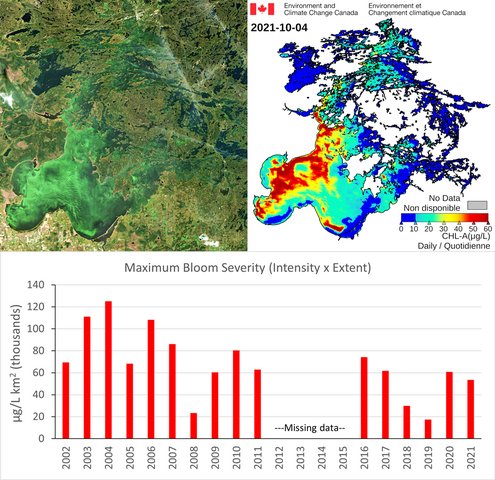The Lake of the Woods Water Sustainability Foundation is pleased to announce the release of the 2022 Rainy-Lake of the Woods State of the Basin Report (SOBR). The 2022 SOBR is available in two versions: a detailed technical report of 148 pages, and an overview report of 32 pages, highlighting key findings and written for a general audience. We encourage you to read the overview version and to explore additional details in the full 148-page version, both of which are available for download at the Foundation’s website, lowwsf.com/sobr.
 The report outlines changes that have occurred since the last report in 2014, focusing on the primary areas of concern in the watershed of nutrients and algae, contaminants, climate change, aquatic invasive species, and erosion/water levels. The report also highlights concerns about the health of the walleye fishery in the north end of Lake of the Woods and includes a new chapter on human health concerns in the watershed.
The report outlines changes that have occurred since the last report in 2014, focusing on the primary areas of concern in the watershed of nutrients and algae, contaminants, climate change, aquatic invasive species, and erosion/water levels. The report also highlights concerns about the health of the walleye fishery in the north end of Lake of the Woods and includes a new chapter on human health concerns in the watershed.
The 2022 SOBR takes first steps towards “two eyed seeing”, by bringing together views of priority concerns and solutions through an Indigenous lens with one eye, while the other eye sees through a Western science lens. The report describes water governance in the basin and Indigenous Knowledge systems and worldview from the standpoint of the Anishinaabe Nation of Treaty #3, US Tribes and the Métis Nation of Ontario. The report also includes aspects of Traditional Knowledge or Indigenous perspective in recognition of a multi-jurisdictional basin. Throughout the report, highlighted are Indigenous concerns or impacts, and questions to shift our lens of view to ensure respect and acknowledgement of the Indigenous Nations in the basin.
The issues of nutrients and algae are ongoing problems in the watershed and especially in Lake of the Woods. Elevated phosphorus concentrations in Lake of the Woods continue to be a concern, with exceedances of Minnesota's state standard and Ontario's water quality objective in late summer and fall. Algal blooms continue plague Lake of the Woods (LoW). Blooms continued in 2021, extending to the north portion of the lake as illustrated by satellite data showing chlorophyll which is a photosynthetic pigment used as an indicator of algal biomass.
 Chlorophyll concentrations on three dates in 2021 in Lake of the Woods (EOLakeWatch, Caren Binding ECCC)
Chlorophyll concentrations on three dates in 2021 in Lake of the Woods (EOLakeWatch, Caren Binding ECCC)
The SOBR reports optimism and significant progress on addressing the problem of nutrients and algal blooms, particularly on Lake of the Woods. Although levels of the nutrient phosphorus are still high and widespread algal blooms continue, there has been much progress in understanding and managing the nutrient phosphorus and its impact on blooms. We are now at a stage ready to move from science to actions to reduce harmful algal blooms.
 Top: Satellite image and derived Chlorophyll-a concentrations, October 4, 2021; Bottom: Maximum bloom severity index on Lake of the Woods, 2002-2021 (SOBR; data and images courtesy of EOLakeWatch).We now have tools to help with this including lake nutrient models, phosphorus reduction targets set by Minnesota, and potential reduction scenarios being considered by Environment and Climate Change Canada (ECCC). We now have satellite tools to measure the extent, intensity, and severity of algal blooms. These satellite tools, developed by ECCC, will likely be very useful to monitor and access progress over the long term. We may have good news to report – the satellite data from ECCC suggest a possible declining trend in algal bloom severity in recent years. This is not certain, given year to year variability and influences of factors such as wind conditions on bloom formation and detection, but it is an encouraging trend to watch.
Top: Satellite image and derived Chlorophyll-a concentrations, October 4, 2021; Bottom: Maximum bloom severity index on Lake of the Woods, 2002-2021 (SOBR; data and images courtesy of EOLakeWatch).We now have tools to help with this including lake nutrient models, phosphorus reduction targets set by Minnesota, and potential reduction scenarios being considered by Environment and Climate Change Canada (ECCC). We now have satellite tools to measure the extent, intensity, and severity of algal blooms. These satellite tools, developed by ECCC, will likely be very useful to monitor and access progress over the long term. We may have good news to report – the satellite data from ECCC suggest a possible declining trend in algal bloom severity in recent years. This is not certain, given year to year variability and influences of factors such as wind conditions on bloom formation and detection, but it is an encouraging trend to watch.
Aquatic invasive species are a significant concern throughout the watershed, with extensive spread of spiny waterflea and rusty crayfish throughout much of the watershed. In recent years, zebra mussel larvae have been detected in the south basin of Lake of the Woods and in Rainy Lake, but no adults or reproductive colonies found in either lake. The report provides updates on many other issues, including contaminants, erosion, climate change, and also identifies a number of knowledge gaps and emerging concerns.
Development of the SOBR was a collaborative effort of LOWWSF the International Rainy-Lake of the Woods Watershed Board, Grand Council Treaty #3, and the research and resource management agencies of the International Multi-Agency Arrangement. Completion of the report would not have been possible without the contributions of numerous researchers, resource managers and agencies in the basin. Special thanks are due to the editorial advisory committee members for Western Science and Indigenous Knowledge.
The report was developed with the financial support of the International Joint Commission’s International Watershed Initiative, the Lake of the Woods Water Sustainability Foundation, Environment and Climate Change Canada’s Lake Winnipeg Basin Program, Grand Council Treaty #3, and inestimable in-kind contributions from researchers, resource managers and agencies in the Rainy-Lake of the Woods Basin.
